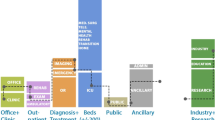Summary
This paper emphasizes the importance of occupational hygiene in the hospital. By taking into account the differences between hospital hygiene and industrial hygiene one realizes that these sciences are quite complementary.
A few occupational stresses or hazards are described some of them being unspecific to the hospital and the other ones being specific i.e. they are not usually present in other industrial situations. Among these are anesthetic gases, ethylene oxide and cytostatic agents. Examples of results obtained during field surveys are given and briefly commented.
The occupational hygienist is an important member of the team aiming at the protection of the workers' health in the hospital.
Zusammenfassung
Spital- und Arbeitshygiene haben unterschiedliche, aber sich gegenseitig ergänzende Schwerpunkte. Für die Gewährleistung von Hygiene und Sicherheit ist die Arbeitshygiene auch im Spitalbetrieb nötig.
Im Spital müssen neben den auch in Industrie und Gewerbe vorkommenden Gesundheitsrisiken auch typisch spitalspezifische Berufsnoxen, wie z.B. Zytostatika, Narkose- und Sterilisationsgase, überwacht werden. So wurde in der vorliegenden Untersuchung gefunden, dass die MAK-Werte von Halothan und Ethylenoxid zum Teil überschritten werden.
Für einen erfolgreichen Gesundheitsschutz im Spital ist eine enge Zusammenarbeit von Spital- und Arbeitshygienikern eine wichtige Voraussetzung.
Similar content being viewed by others
Références
Reber H.: Spitalhygiene, Swiss Med.1, 52–59 (1979)
Lewy R.: Prevention Strategies in Hospital Occupational Medicine. JOM23, 109–111 (1981)
NIOSH, criteria for a recommended standard…. occupational exposure to waste anesthetic gases and vapors. DHEW 77–140 (1977)
Boillat M.-A. et col.: Surveillance médicale de personnes exposées aux gaz anesthésiques. Méd. soc. prév.27, 256–257 (1982)
Garry V.F. et col.: Ethylene oxide: evidence of human chromosome effect. Environmental mutagenesis1, 375–382 (1979)
Hogstedt C. et col.: A cohort study of mortality and cancer incidence in ethylene oxide production workers. Brit. J. Ind. Med.36, 276–280 (1979)
Falch K. et col.: Mutagenicity in urine of nurses handling cytostatic drugs. Lancet1, 1250–1251 (1979)
Bos R.P.: Mutagenicity of urine from nurses handling cytostatic drugs, influence of smoking. Int. Arch. Occup. Environ. Health:50, 359–369 (1982)
Author information
Authors and Affiliations
Rights and permissions
About this article
Cite this article
Droz, P.O., Guillemin, M. L'hygiène du travail dans les hôpitaux. Soz Präventivmed 29, 7–10 (1984). https://doi.org/10.1007/BF02301720
Published:
Issue Date:
DOI: https://doi.org/10.1007/BF02301720




